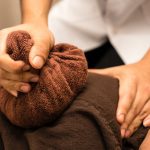- Introduction
- Thai Massage Techniques Explained: From Stretching to Pressure Points
- Roots & Philosophy: From Monastic Wisdom to Modern Wellness
- Core Concepts: Sen Lines, Pressure Points & Assisted Stretching
- Thai Massage Techniques Explained: A Practical Walk-Through
- Thai Yoga Massage Stretches: The Dynamic Flow
- Northern (Chiang Mai) vs Southern (Bangkok) Styles
- Choose the Right Technique for Your Ailment
- How a Therapist Personalizes Your Session
- Session Logistics: What to Expect & How to Prepare
- Enhancements & Pairings That Amplify Results
- Integrating Thai Massage into a Modern Wellness Plan
- Quick Reference: What to Ask For (By Goal)
- Conclusion: A Practice That Listens
- FAQs about Thai Massage Techniques
Introduction
If you’ve ever wondered how Thai massage seems to stretch, calm, and recharge you all at once, this is your guide to Thai massage techniques explained. More than just a spa ritual, Thai massage is an ancient blend of assisted stretching, acupressure, and mindful rhythm designed to restore balance along invisible Sen lines—the body’s energy pathways.
Rooted in Buddhist healing traditions and influenced by Ayurveda, Thai massage is sometimes called “lazy yoga” because the therapist moves you through poses that mirror yoga postures. Yet beneath the calm lies a sophisticated system of pressure points and dynamic Thai yoga massage stretches that target both body and mind.
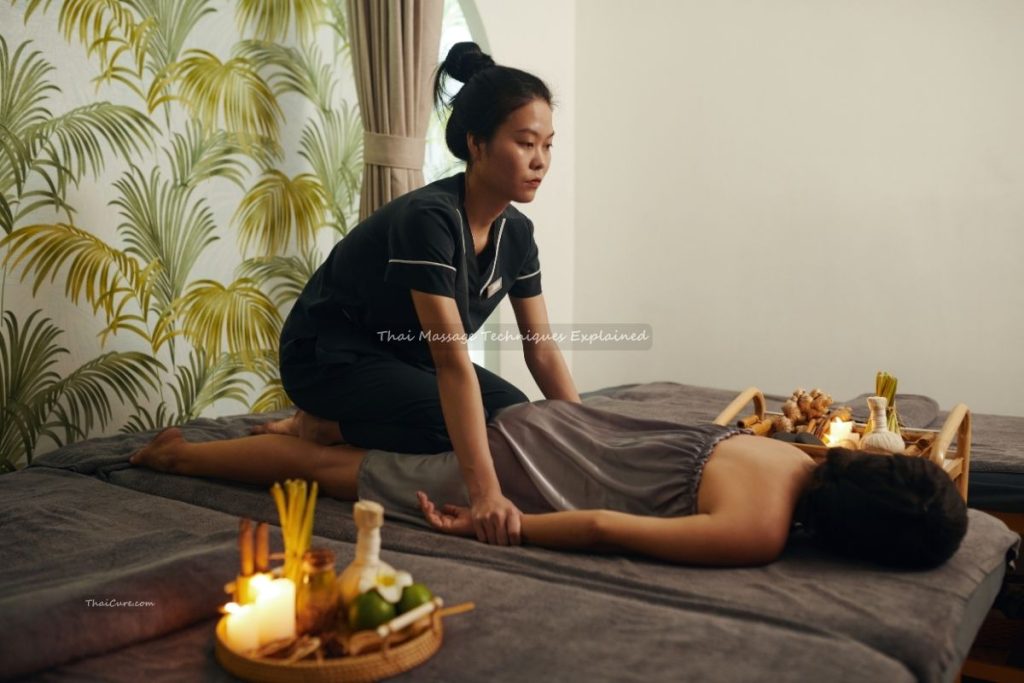
In this article, we’ll demystify the philosophy behind Thai massage, explore its key techniques, and explain how styles differ between Northern (Chiang Mai) and Southern (Bangkok) schools. Whether you’re seeking relief from back pain, improved flexibility, or just a deeper connection to your body’s natural flow, you’ll find everything you need to understand—and truly appreciate—this timeless healing art.
👉 “Looking to discover how these techniques boost overall wellness? Don’t miss our guide on Thai Massage Benefits: Thai Wellness, Herbs & Spa.”
Thai Massage Techniques Explained: From Stretching to Pressure Points
If you’ve ever stepped out of a Thai spa feeling taller, lighter, and somehow more “connected,” you’ve already met the unique rhythm of Thai bodywork. In this thai massage techniques explained guide, we’ll unpack how Thai therapists blend assisted stretching, compression, and precise pressure points to help your body reset. We’ll demystify Sen lines (energy pathways), show how thai yoga massage stretches work in practice, and compare Northern (Chiang Mai) and Southern (Bangkok) styles so you can match techniques to your real-world needs—whether that’s office-desk tightness, running aches, or stress that’s crept into your shoulders.
What sets Thai massage apart is the dynamic, mindful flow. Instead of oil and a table, sessions often happen on a mat with you fully clothed. Your therapist uses palms, thumbs, elbows, knees, and sometimes feet, moving your body through ranges of motion while maintaining a steady breath and tempo. Think of it as passive yoga combined with acupressure: you receive the benefits of deep stretching without doing the work, while targeted pressure points help relieve stubborn tension. This article gives you the full picture—thai massage techniques explained clearly and practically—so you know what to request and why it matters.
👉 “Thinking about starting Thai massage practice at home or professionally? You’ll love our guide on The Essential tools for Thai massage therapy.”
Roots & Philosophy: From Monastic Wisdom to Modern Wellness
Traditional Thai massage (Nuad Thai) traces its lineage through temple teachings and regional practice. While historical details vary, the core philosophy is consistent: movement, breath, and touch can balance the body’s internal pathways—often called Sen lines or energy lines. Therapists work these lines with rhythmic compression and acupressure, then open related joints and muscles with assisted stretches. The intention isn’t just “fixing a sore spot”; it’s re-organizing patterns so the whole body cooperates again.
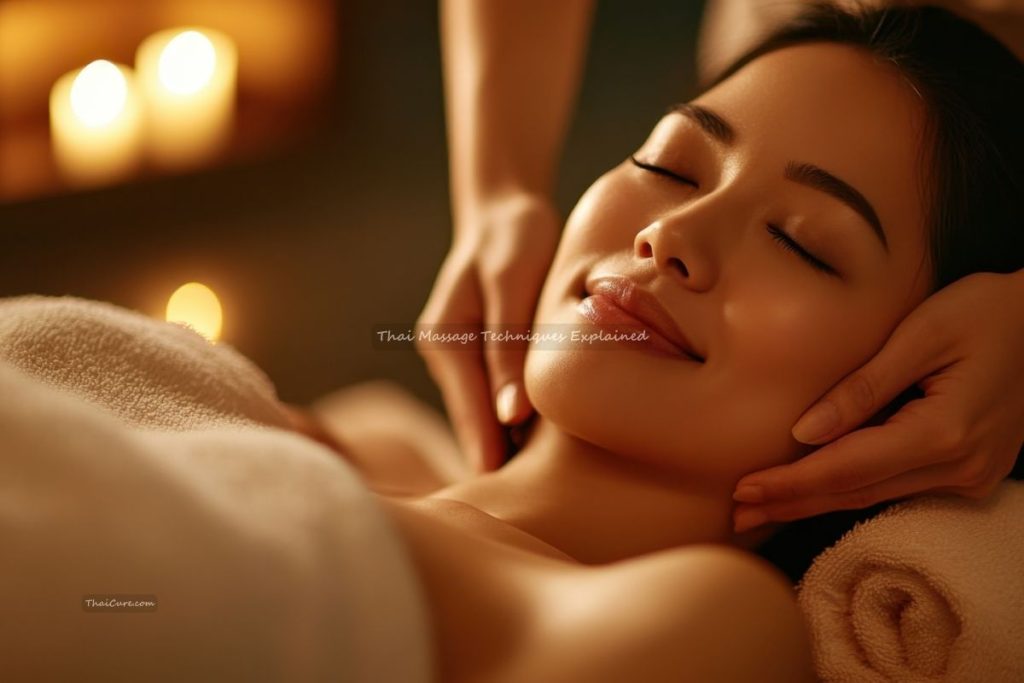
In daily Thai life, you’ll still find massage woven into wellness routines. Markets and neighborhoods might host small massage houses where people drop in for a 30- to 90-minute tune-up. Spas add enhancements—Thai herbal compress (luk pra kob), foot work, or aroma steams—to elevate the experience. But whether you’re in a village setting or a luxury spa, the underlying idea is the same: restore flow along Sen lines, release restrictions, and refresh the nervous system.
Core Concepts: Sen Lines, Pressure Points & Assisted Stretching
Before we explore the menu of methods, let’s clarify the three pillars you’ll feel in almost any session:
1) Sen Lines (Energy Pathways)
Sen lines are conceptual routes therapists follow to influence circulation, loosen fascial “stickiness,” and calm the nervous system. Working along a Sen pathway often combines broad palm pressure with focused thumb work. You’ll notice an ebb-and-flow cadence: gentle compression, a moment of hold, then a slow release.
2) Pressure Points & Acupressure
Thai therapists apply pressure points to interrupt pain cycles, release trigger zones, and stimulate fresh blood flow. As part of acupressure, these points are pressed with thumbs or elbows and held just long enough for tissue to “melt.” The therapist watches your breath and facial cues to choose depth and duration—more warmth than shock, more relief than intensity.
3) Assisted Stretching (Passive Yoga)
The iconic images of Thai massage—hip openers, spinal twists, hamstring glides—come from assisted stretching. Coordinated with steady breathing, these movements gently “invite” length rather than forcing it. When a therapist times a stretch to your exhale, muscles let go far more readily. This pairing is the basis of thai yoga massage stretches, the dynamic cousin of static stretching.
Thai Massage Techniques Explained: A Practical Walk-Through
When people ask for thai massage techniques explained, they usually want to know, “What exactly will the therapist do?” Here’s a clear look at the methods you’re most likely to experience:
Palming & Rolling Compression
Long, open-hand compressions sweep along thighs, back, and shoulders. Palming warms tissues and maps areas of restriction. Rolling compression (often with the heel of the hand) gives a broader, soothing pressure—ideal for warming up before deeper work.
Thumb Work on Sen Lines
Direct, slower thumb pressure traces key Sen lines. This is where precision shines: the therapist feels subtle density changes and lingers on knots or tender bands. It’s focused enough to change stubborn spots without overwhelming the area.
Elbow & Forearm Techniques
Once you’re warmed up, elbows and forearms can address deep glute, calf, or back tension. The pressure is applied gradually, with the therapist often shifting their body weight rather than “pushing” from the arm—making the sensation surprisingly comfortable when done well.
Rocking, Shaking & Rhythmic Mobilization
Small rocking motions help your nervous system let go. Gentle oscillations around the hips or shoulders prepare joints for deeper ranges and signal safety to tight muscles. In many sessions, this rhythmic element is the turning point where protection gives way to release.
Joint Traction & Decompression
You might feel a therapist cradle a joint and apply a gentle pull. This traction can ease joint space, reduce compressive stress, and improve glide. It’s especially helpful before larger thai yoga massage stretches for hips, shoulders, and lower back.
Classic Assisted Stretches
- Hip Openers: Figure-four variations, cross-body hip rotations, and adductor lengthening improve gait and reduce lower-back load.
- Hamstrings & Calves: Progressive lengthening with breath-timing; perfect for runners or anyone desk-bound.
- Spinal Twists: Supine or side-lying rotations that decompress the lumbar region and refresh posture.
- Shoulder & Chest: Pectoral opens and shoulder extension help counter “rounded desk posture.”
Pressure Points for Common Complaints
- Lower Back & Hips: Points along glute medius and piriformis, plus lumbar paraspinals.
- Neck & Shoulders: Suboccipital holds, upper trap points, and pec minor releases to balance forward head posture.
- Headaches & Jaw Tension: Scalp, temples, and jawline points combined with breath work.
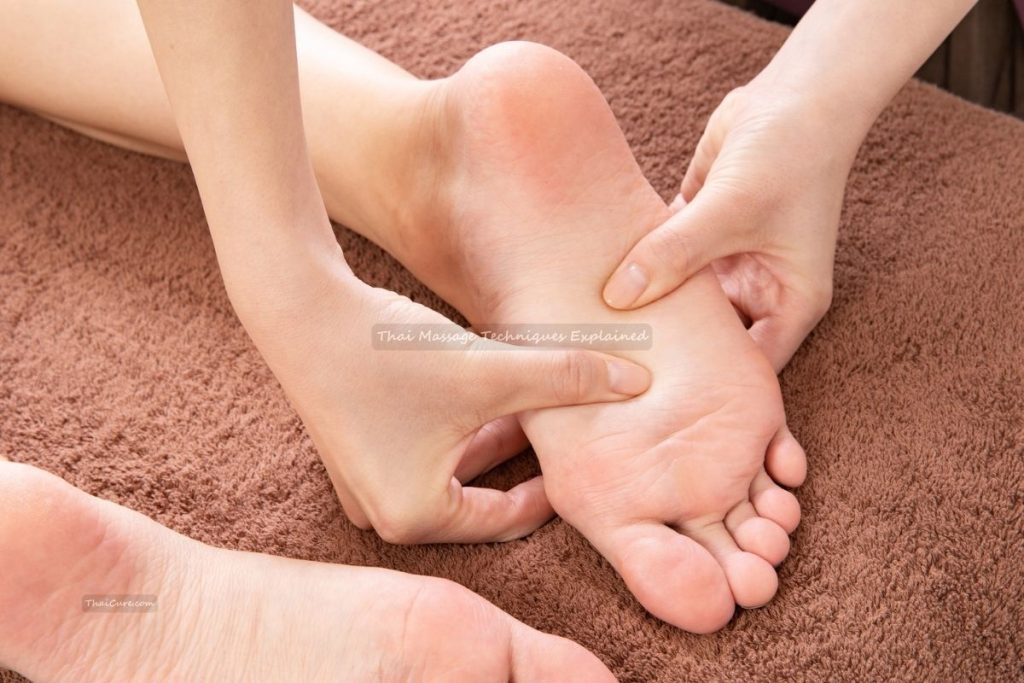
Throughout, the therapist blends these tools like a sequence: warm (palming), focus (acupressure on pressure points), mobilize (rocking), lengthen (stretch), then quiet (hold and breathe). That’s thai massage techniques explained in practice—an elegant, layered progression.
Thai Yoga Massage Stretches: The Dynamic Flow
Let’s zoom in on thai yoga massage stretches, the athletic, breath-synchronized heart of many sessions. The aim is functional range, not circus poses. Done properly, stretches feel like your body is being guided along rails it always wanted to travel.
Lower Body Flow (Hips & Hamstrings)
A therapist may start with hip flexor lengthening to free the pelvis, then glide into hamstring work. By alternating sides and angles, the nervous system stays relaxed and responsive. Adding gentle ankle pumps during a hamstring stretch encourages circulation and reduces the “rubber band” snap-back.
Spine & Thoracic Mobility
Side-lying rotations, supported spinal twists, and chest openings help you reclaim upright posture. Desk workers find these especially helpful: opening the thoracic spine takes pressure off the lumbar region and shoulders.
Shoulders, Neck & Chest
Think of the shoulders as a 360-degree hub. Therapists use traction, cross-body reaches, and chest openers to restore balance. Coupled with precise acupressure at the base of the skull, these moves can ease tension headaches and neck fatigue.
Safety & Sensation
Good stretching is invitational, not confrontational. Expect slow entry, a pause at the barrier, then a small breath-led increase. Communication matters—tell your therapist when a stretch feels “sharp” versus “deep but good.” That distinction keeps thai yoga massage stretches therapeutic and safe.
Northern (Chiang Mai) vs Southern (Bangkok) Styles
Regional nuances give Thai massage its delightful variety. While every therapist is unique, there are recognizable trends:
- Northern Thai massage (Chiang Mai style): Often a gentler, more meditative cadence with flowing transitions and longer holds. Expect more rocking, broad palm work, and a graceful emphasis on sequence.
- Southern Thai massage (Bangkok style): Tends to be brisker and more direct, with punchier compression and clearly defined point work. It can feel “sportier” and is popular with clients who like decisive, structured pressure.
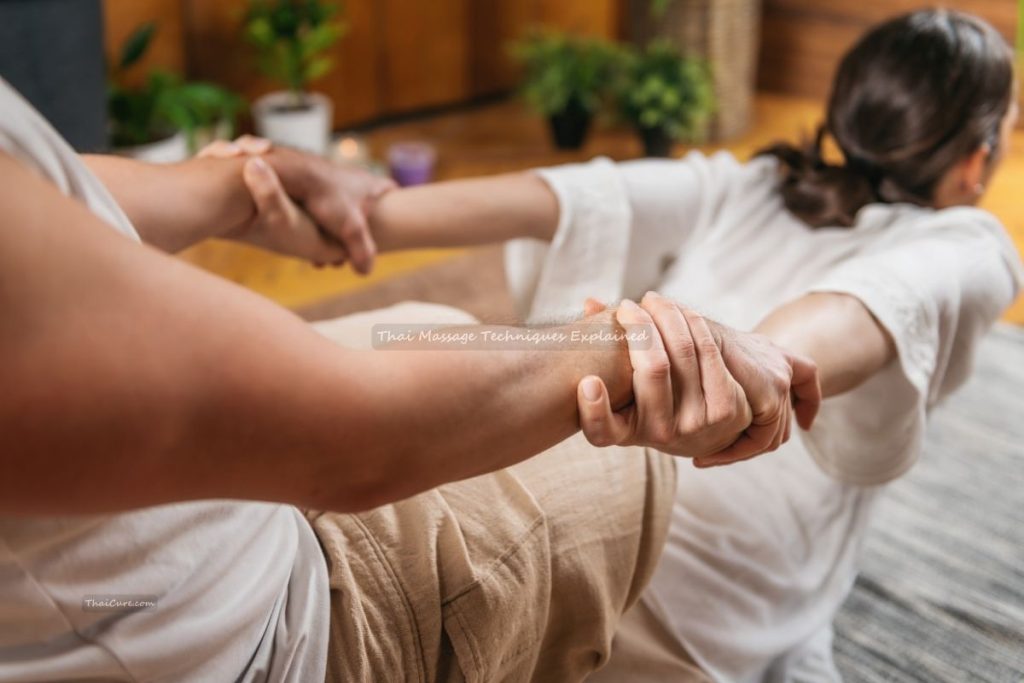
If you’re sensitive or new to bodywork, the northern thai massage feel might suit you. If you prefer clear intensity with crisp edges, the southern thai massage flavor may be your match. Many modern therapists blend both, adapting to your goals and tolerance.
Choose the Right Technique for Your Ailment
This is where the knowledge becomes practical. Use the guide below to discuss goals with your therapist. (Note: Massage supports well-being; it is not a substitute for medical care. If you have injuries or conditions, consult a professional first.)
Back Pain & Hip Tightness
- Ask for: broad palming warm-up, pressure points on glutes and low back, hip traction, hamstring and hip-flexor stretches.
- Keywords in practice: thai massage for back pain, assisted hip openers, lumbar decompression ideas.
Sciatica-Like Symptoms
- Ask for: gentle glute piriformis work, thigh rotations, progressive hamstring lengthening, sacral rocking.
- Keywords in practice: thai massage for sciatica, targeted acupressure along gluteal lines.
Neck & Shoulder Strain (Desk Posture)
- Ask for: pec minor release, suboccipital holds, shoulder traction, thoracic rotations, thai yoga massage stretches for chest.
- Keywords in practice: thai massage for neck and shoulder pain, postural resets.
Headaches, Jaw Tension & Eye Fatigue
- Ask for: scalp and temple points, gentle jawline pressure points, upper-back mobility, breath pacing.
- Pair with: warm Thai herbal compress across neck/shoulders.
Stress Relief & Sleep Support
- Ask for: rhythmic rocking, slow palming, longer holds along Sen lines.
- Keywords in practice: thai massage benefits for nervous system downshifting, breath-led sequencing.
Runners & Active Folks
- Ask for: calves, hamstrings, hip flexors, and ankle mobility, followed by full-chain assisted stretching and joint traction.
- Add-ons: thai foot reflexology to finish—grounding and great for recovery.
How a Therapist Personalizes Your Session
A skilled practitioner treats the protocol like sheet music—then plays jazz for your body. They’ll watch how you breathe, where you guard, how joints glide, and which tissues “talk back.” Expect them to:
- Assess Quickly: Palming sweeps reveal heat, tone, and texture.
- Sequence Smartly: Warm → point → mobilize → stretch → integrate.
- Modulate Pressure: They’ll adjust angle and leverage (thumb vs elbow) to keep depth therapeutic, not punitive.
- Co-Create Pace: Your breath is the metronome. Exhales unlock range; inhales stabilize.
- Close with Quiet: Gentle holds or a still hand over the abdomen settles the nervous system so benefits “stick.”
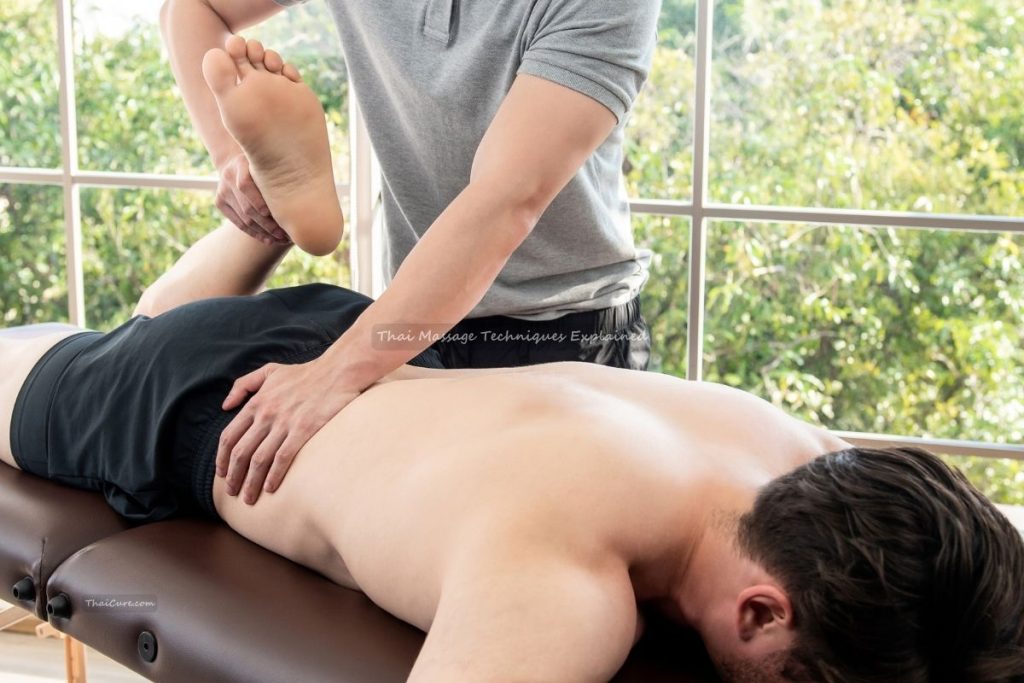
This, in essence, is thai massage techniques explained from the inside—how a talented therapist blends structure and intuition.
Session Logistics: What to Expect & How to Prepare
- Clothing: Wear stretchy, breathable layers. You should move freely through full ranges.
- Communication: Share your goals (e.g., “long-haul flight hips,” “hamstrings for running,” “jaw tension”). Mention past injuries.
- Discomfort vs Pain: A “hurts-so-good” depth can be therapeutic; sharp, nervy, or breath-catching pain is your cue to ask for a change.
- Hydration & Aftercare: Drink water, take an easy walk, and avoid maximal workouts immediately afterward. Gentle motion helps integrate the work.
- Frequency: For maintenance, once every 2–4 weeks is common. During intense training or long desk periods, weekly for a short cycle can help.
Enhancements & Pairings That Amplify Results
- Thai herbal compress (Luk Pra Kob): Warm bundles of aromatic herbs soften tissue, making acupressure and stretching more comfortable.
- Thai foot reflexology: A grounding way to finish sessions, helpful for sleep, digestion rhythms, and stress reduction.
- Breath Coaching: Simple count breathing (inhale 4, exhale 6) deepens release during pressure points and stretches.
- Home Support: Between sessions, try 5–7 minutes of supine hamstring flossing, thoracic openers over a pillow, and a nightly neck lengthening sequence.
Integrating Thai Massage into a Modern Wellness Plan
You don’t need a complete life overhaul to benefit. Slot a 60- or 90-minute session around key stressors: after travel, before a busy work sprint, or in the taper week before a race. Consider alternating styles—one session with a northern thai massage flow for deeper relaxation, followed by a southern thai massage-influenced visit to address specific hotspots. Combine with strength and mobility work to “lock in” new range. Over time, you’ll notice less effort needed to maintain posture, more spring in your stride, and a steadier nervous system.
If you’re building a spa routine, ask about series pricing and seasonal specials that include thai yoga massage stretches, Thai herbal compress, or reflexology. With smart scheduling and clear goals, you transform occasional self-care into a reliable system.
Quick Reference: What to Ask For (By Goal)
- Desk-Stiff Posture: Thoracic rotations, chest openers, suboccipital holds, shoulder traction.
- Lower-Back Relief: Hip traction, glute point work, hamstring and hip-flexor stretches.
- Runner’s Reset: Calf, hamstring, and hip sequences + ankle mobility and joint traction.
- Stress Downshift: Rocking, broad palming along Sen lines, slow holds, longer exhales.
- Headache Help: Scalp and temple pressure points, jawline release, upper-back mobility.
Conclusion: A Practice That Listens
At its best, Thai massage is a conversation—one where hands listen, breath answers, and patterns reorganize. With thai massage techniques explained in plain language, you can step into sessions with clarity: ask for the flow you prefer, request pressure points where you need focus, and enjoy the meditative rhythm of thai yoga massage stretches. Whether you lean toward the fluid grace of northern thai massage or the crisp precision of southern thai massage, the goal is the same—restore movement, soothe the nervous system, and help you feel at home in your body again.
FAQs about Thai Massage Techniques
1. What are the main Thai massage techniques?
Traditional Thai massage combines acupressure, stretching, and rhythmic compression. Therapists work along Sen lines—energy pathways—to balance the body, using palms, thumbs, elbows, and even feet. These Thai massage techniques encourage flexibility, relaxation, and natural energy flow.
2. How do Thai yoga massage stretches differ from regular yoga?
Thai yoga massage stretches are performed for you—think of it as passive yoga. The therapist gently guides your body through movement while synchronizing breath and rhythm. It’s less about self-effort and more about releasing stored tension safely and effectively.
3. What are Sen lines in Thai massage?
Sen lines are believed to be the body’s internal energy highways. By applying pressure points and rhythmic movement along these lines, Thai massage aims to restore balance and improve circulation. This ancient principle connects physical, emotional, and spiritual well-being.
4. Which Thai massage techniques help with back or neck pain?
For back pain, therapists often combine deep acupressure, gentle assisted stretching, and targeted Thai massage techniques for back pain. For neck and shoulder issues, pressure points near the upper spine and chest openers inspired by Thai yoga massage stretches provide relief.
5. How often should I get a Thai massage for best results?
For general wellness, once or twice a month maintains flexibility and stress relief. Those addressing chronic pain might benefit from weekly sessions focusing on thai massage techniques explained in this guide—especially northern Thai massage for relaxation or southern Thai massage for intensity.


